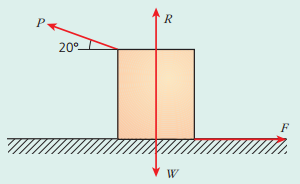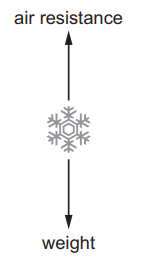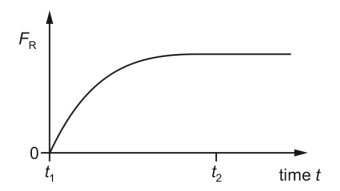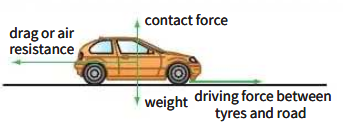Question 1
A box of mass 5.0 kg is pulled along a horizontal floor by a force P of 25 N, applied at an angle of 20° to the horizontal (figure). A frictional force F of 20 N acts parallel to the floor. Calculate the acceleration of the box.

Medium
Mark as Complete
Mark Scheme
Question 2
Draw a diagram to show the forces that act on a car as it travels along a level road at its top speed.
Easy
Mark as Complete
Mark Scheme
Question 3
An object falls from a stationary helicopter and reaches terminal velocity. What happens to the acceleration of the object between leaving the helicopter and reaching terminal velocity?
A. It decreases to 9.81 m.s–2.
B. It decreases to zero.
C. It increases to 9.81 m.s–2.
D. It remains constant at 9.81 m.s–2.
Easy
Mark as Complete
Mark Scheme
Question 4
Explain the changes in the resultant force acting on an object as it moves through a fluid.
a. As the object falls vertically downwards.
b. As the object moves vertically upwards in a fluid.
Medium
Mark as Complete
Mark Scheme
Question 5
A snowflake is falling from the sky on a still day. Its weight acts vertically downwards and air resistance acts vertically upwards. As the snowflake falls, air resistance increases until it is equal to the weight and there is no resultant force acting on the snowflake.
 When the forces become equal, which statement is correct?
When the forces become equal, which statement is correct?
A. The snowflake accelerates.
B. The snowflake decelerates.
C. The snowflake is stationary.
D. The snowflake moves at a constant velocity.
Medium
Mark as Complete
Mark Scheme
Question 6
A light ball is falling vertically through air.
The variation with time t of the resistive force FR acting on the ball is shown.
At which times are the speed of the ball zero, the speed at a maximum and the acceleration zero?
| zero speed | maximum speed | zero acceleration | |
|---|---|---|---|
| A | t₁ | t₂ | t₁ |
| B | t₁ | t₂ | t₂ |
| C | t₂ | t₁ | t₁ |
| D | t₂ | t₁ | t₂ |
Medium
Mark as Complete
Mark Scheme
Question 7
A sphere falls from rest through the air. The graph shows the variation with time of the sphere’s velocity.
 Which diagram shows the forces acting on the sphere when it is at the velocity corresponding topoint P on the graph?
Which diagram shows the forces acting on the sphere when it is at the velocity corresponding topoint P on the graph?
Medium
Mark as Complete
Mark Scheme
Question 8
These two diagrams show the forces acting on a parachutist at different points as he falls towards the ground.
The lengths of the arrows represent the relative sizes of the forces.
a. Name the two forces acting upwards and downwards on the parachutist.
b. Which of the two diagrams represents the forces acting when the parachutist is moving more quickly through the air? Explain how you know.
c. Which of the diagrams represents the forces acting as the parachutist falls at a slow, steady speed? Explain how you know.
d. A parachutist falls freely through the air before opening his parachute. Explain why he decelerates when his parachute opens.
Easy
Mark as Complete
Mark Scheme
Question 9

Hard
Mark as Complete
Mark Scheme
Question 10
A ball falls from rest through air and eventually reaches a constant velocity. For this fall, forces X and Y vary with time as shown.

What could be forces X and Y?
| force X | force Y | |
|---|---|---|
| A | air resistance | resultant force |
| B | air resistance | weight |
| C | upthrust | resultant force |
| D | upthrust | weight |
Hard
Mark as Complete
Mark Scheme
Question 1
A box of mass 5.0 kg is pulled along a horizontal floor by a force P of 25 N, applied at an angle of 20° to the horizontal (figure). A frictional force F of 20 N acts parallel to the floor. Calculate the acceleration of the box.

The free-body diagram is shown in figure. Resolving the forces parallel to the floor, the component of the pulling force, acting to the left, is `25cos20^o="23.5 N"`.
The frictional force, acting to the right, is 20 N.
The resultant force to the left is thus `"23.5 N" - "20 N"= "3.5 N"`
From Newton’s second law: `"acceleration"="3.5 N"/"5 kg"=0.7 " m"."s"^-2`.
Question 2
Draw a diagram to show the forces that act on a car as it travels along a level road at its top speed.

Question 3
An object falls from a stationary helicopter and reaches terminal velocity. What happens to the acceleration of the object between leaving the helicopter and reaching terminal velocity?
A. It decreases to 9.81 m.s–2.
B. It decreases to zero.
C. It increases to 9.81 m.s–2.
D. It remains constant at 9.81 m.s–2.
Answer: B
A. Incorrect: The acceleration doesn't decrease to 9.81 m.s-2 ; it decreases to zero when terminal velocity is reached because forces balance out.
B. Correct: When the object starts falling, gravity acts on it, causing an initial acceleration of 9.81 m.s-2. As the object speeds up, air resistance increases. The object accelerates until air resistance equals its weight (gravitational force), at which point it reaches terminal velocity and stops accelerating. Therefore, the acceleration decreases to zero as the object reaches terminal velocity.
C. Incorrect: The object starts with 9.81 m.s-2 but its acceleration decreases as air resistance increases until it becomes zero at terminal velocity.
D. Incorrect: The object doesn't maintain a constant acceleration of 9.81 m.s-2. The acceleration decreases over time as air resistance increases.
Question 4
Explain the changes in the resultant force acting on an object as it moves through a fluid.
a. As the object falls vertically downwards.
b. As the object moves vertically upwards in a fluid.
a. When the object falls vertically downwards in a fluid:
As the object falls downwards, it experiences a gravitational force acting downwards.
Additionally, the object experiences a drag force acting upwards due to the resistance from the fluid it is moving through.
Initially, when the object starts falling, the gravitational force is greater than the drag force, resulting in a net downward force (resultant force) acting on the object.
As the object accelerates downwards, the drag force increases due to the object's speed, eventually reaching a point where the drag force equals the gravitational force.
At this point, the net force acting on the object becomes zero, and the object falls at a constant speed known as the terminal velocity.
b. When the object moves vertically upwards in a fluid:
As the object moves upwards, it still experiences the gravitational force acting downwards.
In this case, the drag force acts in the opposite direction, opposing the motion of the object.
Initially, when the object starts moving upwards, the gravitational force is greater than the drag force, resulting in a net downward force acting on the object.
As the object accelerates upwards, the drag force increases due to the object's speed, eventually reaching a point where the drag force equals the gravitational force.
At this point, the net force acting on the object becomes zero, and the object moves at a constant speed in the upward direction.
Question 5
A snowflake is falling from the sky on a still day. Its weight acts vertically downwards and air resistance acts vertically upwards. As the snowflake falls, air resistance increases until it is equal to the weight and there is no resultant force acting on the snowflake.
 When the forces become equal, which statement is correct?
When the forces become equal, which statement is correct?
A. The snowflake accelerates.
B. The snowflake decelerates.
C. The snowflake is stationary.
D. The snowflake moves at a constant velocity.
Answer: D
A. Incorrect: The forces are balanced, so there is no net force, and the snowflake no longer accelerates.
B. Incorrect: Deceleration only happens if the object is slowing down, but here the speed remains constant once the forces balance.
C. Incorrect: The snowflake is falling at a constant speed, not stationary.
D. Correct: Once the forces balance, the snowflake falls at a constant speed (terminal velocity).
Question 6
A light ball is falling vertically through air.
The variation with time t of the resistive force FR acting on the ball is shown.
At which times are the speed of the ball zero, the speed at a maximum and the acceleration zero?
| zero speed | maximum speed | zero acceleration | |
|---|---|---|---|
| A | t₁ | t₂ | t₁ |
| B | t₁ | t₂ | t₂ |
| C | t₂ | t₁ | t₁ |
| D | t₂ | t₁ | t₂ |
Answer: B
Zero speed: When the ball starts to fall, its speed is zero. This happens at t1.
Maximum speed: The ball continues to accelerate until the air resistance (resistive force) increases and balances the gravitational force. At this point, the speed of the ball reaches its maximum. This happens at t2, when the ball reaches terminal velocity.
Zero acceleration: When the resistive force equals the gravitational force, there is no net force acting on the ball, and the ball stops accelerating. This means the acceleration is zero. This happens at t2, when the ball has reached constant velocity.
Question 7
A sphere falls from rest through the air. The graph shows the variation with time of the sphere’s velocity.
 Which diagram shows the forces acting on the sphere when it is at the velocity corresponding topoint P on the graph?
Which diagram shows the forces acting on the sphere when it is at the velocity corresponding topoint P on the graph?
Answer: C
A. Incorrect: This shows air resistance and weight both acting in the same direction, which is incorrect because the two forces act in opposite directions.
B. Incorrect: This shows air resistance and weight acting in opposite directions but with equal magnitudes. At point P, the forces are not yet balanced because the sphere is still accelerating.
C. Correct: At point P, the sphere has reached a velocity where the air resistance is approaching but has not yet balanced the weight of the sphere. This means that the sphere is still accelerating but at a decreasing rate. The force diagram at this point should show both weight and air resistance acting in opposite directions, with weight still being greater than air resistance.
D. Incorrect: This shows air resistance and weight acting in the same direction, which is incorrect because air resistance opposes the weight.
Question 8
These two diagrams show the forces acting on a parachutist at different points as he falls towards the ground.
The lengths of the arrows represent the relative sizes of the forces.
a. Name the two forces acting upwards and downwards on the parachutist.
b. Which of the two diagrams represents the forces acting when the parachutist is moving more quickly through the air? Explain how you know.
c. Which of the diagrams represents the forces acting as the parachutist falls at a slow, steady speed? Explain how you know.
d. A parachutist falls freely through the air before opening his parachute. Explain why he decelerates when his parachute opens.
a. Upward force = drag (air resistance); downward force = weight.
b. Diagram 1; air resistance is greater than in diagram 2.
c. Diagram 2; the two forces are equal and opposite.
d. Air resistance is much greater than his downward weight, so there is a resultant force which acts upwards.
Question 9

Answer: B
A. Incorrect: This graph suggests a continuous increase in acceleration, but once the sky-diver reaches terminal velocity, her acceleration should decrease, and the displacement will level off. This graph does not match the description.
B. Correct:
As the sky-diver falls:
Initially, the displacement increases with time, and the acceleration is high because air resistance is small compared to her weight.
As the sky-diver speeds up, air resistance increases. When air resistance equals her weight, her speed stabilizes, and the displacement continues to increase at a decreasing rate, reflecting a constant velocity after reaching terminal velocity.
C. Incorrect: This graph initially shows a rapid increase in displacement, but then the curve bends in an unrealistic way, which doesn't correspond to the sky-diver's actual motion. The displacement should continue to increase more gradually after terminal velocity is reached.
D. Incorrect: This graph shows a linear relationship between displacement and time, which would only occur if the sky-diver were falling at a constant speed from the start, but initially, her speed increases as she accelerates until she reaches terminal velocity.
Question 10
A ball falls from rest through air and eventually reaches a constant velocity. For this fall, forces X and Y vary with time as shown.

What could be forces X and Y?
| force X | force Y | |
|---|---|---|
| A | air resistance | resultant force |
| B | air resistance | weight |
| C | upthrust | resultant force |
| D | upthrust | weight |
Answer: A
A. Correct:
Force X is air resistance. As the ball falls, air resistance increases with time as its speed increases.
Force Y is the resultant force. Initially, the ball accelerates because air resistance is less than the weight. As air resistance increases, the resultant force decreases until it becomes zero when air resistance equals weight, reaching terminal velocity.
B. Incorrect: This is incorrect because weight is constant, while air resistance changes over time. The graph of force Y doesn't match this, as it shows a decreasing force (resultant force), not a constant force (like weight).
C. Incorrect: Upthrust (buoyant force) is not relevant in this scenario. The ball is falling through air, not in a fluid where buoyancy is a factor. Therefore, this is incorrect.
D. Incorrect: Upthrust is not relevant in the context of an object falling through air. The forces involved are air resistance and weight, so this option is also incorrect.
Question 1
A box of mass 5.0 kg is pulled along a horizontal floor by a force P of 25 N, applied at an angle of 20° to the horizontal (figure). A frictional force F of 20 N acts parallel to the floor. Calculate the acceleration of the box.

Question 2
Draw a diagram to show the forces that act on a car as it travels along a level road at its top speed.
Question 3
An object falls from a stationary helicopter and reaches terminal velocity. What happens to the acceleration of the object between leaving the helicopter and reaching terminal velocity?
A. It decreases to 9.81 m.s–2.
B. It decreases to zero.
C. It increases to 9.81 m.s–2.
D. It remains constant at 9.81 m.s–2.
Question 4
Explain the changes in the resultant force acting on an object as it moves through a fluid.
a. As the object falls vertically downwards.
b. As the object moves vertically upwards in a fluid.
Question 5
A snowflake is falling from the sky on a still day. Its weight acts vertically downwards and air resistance acts vertically upwards. As the snowflake falls, air resistance increases until it is equal to the weight and there is no resultant force acting on the snowflake.
 When the forces become equal, which statement is correct?
When the forces become equal, which statement is correct?
A. The snowflake accelerates.
B. The snowflake decelerates.
C. The snowflake is stationary.
D. The snowflake moves at a constant velocity.
Question 6
A light ball is falling vertically through air.
The variation with time t of the resistive force FR acting on the ball is shown.
At which times are the speed of the ball zero, the speed at a maximum and the acceleration zero?
| zero speed | maximum speed | zero acceleration | |
|---|---|---|---|
| A | t₁ | t₂ | t₁ |
| B | t₁ | t₂ | t₂ |
| C | t₂ | t₁ | t₁ |
| D | t₂ | t₁ | t₂ |
Question 7
A sphere falls from rest through the air. The graph shows the variation with time of the sphere’s velocity.
 Which diagram shows the forces acting on the sphere when it is at the velocity corresponding topoint P on the graph?
Which diagram shows the forces acting on the sphere when it is at the velocity corresponding topoint P on the graph?
Question 8
These two diagrams show the forces acting on a parachutist at different points as he falls towards the ground.
The lengths of the arrows represent the relative sizes of the forces.
a. Name the two forces acting upwards and downwards on the parachutist.
b. Which of the two diagrams represents the forces acting when the parachutist is moving more quickly through the air? Explain how you know.
c. Which of the diagrams represents the forces acting as the parachutist falls at a slow, steady speed? Explain how you know.
d. A parachutist falls freely through the air before opening his parachute. Explain why he decelerates when his parachute opens.
Question 9

Question 10
A ball falls from rest through air and eventually reaches a constant velocity. For this fall, forces X and Y vary with time as shown.

What could be forces X and Y?
| force X | force Y | |
|---|---|---|
| A | air resistance | resultant force |
| B | air resistance | weight |
| C | upthrust | resultant force |
| D | upthrust | weight |